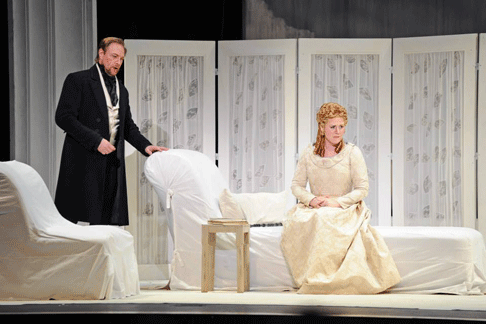She remembered the party at which she first met Alfredo as a study in shades of red. The scene at her country home was all in light neutrals while Flora’s party was held amongst dark shades that portended darker events.
The libretto for Verdi’s La traviata is based on the life of Alphonsine Rose Plessis, a French “call girl” who changed her name to Marie and mixed with upper class men in the early years of the nineteenth century. Verdi first called the opera Violetta after the name he and librettist Francesco Maria Piave gave the title character, but the more disparaging term Traviata or fallen woman better fit the mindset of the time. Piave based the libretto on the text of the play, La dame aux CamÈlias. The play grew out of a novel by Alexandre Dumas, fils, who had actually known the woman. Franz Liszt knew her, too, as did many artists of the time, because she was well read and a good conversationalist.
In truth, Marie had little schooling, but combined physical beauty with a natural refinement. An English gentleman recalling her said, “Her inbred tact and instinctive delicacy compensated for a totally inadequate education. Whatever she recognized as admirable in her friends she strove to master herself, so that her natural appeal was enhanced by the flower of her intelligence.” She died of tuberculosis at the age of twenty-three. After a lavish funeral at the church of La Madeleine, her possessions were auctioned off, her debts were paid, and her sister Delphine inherited enough money to open a modest shop.
 Mark Walters as Germont asks Caitlin Lynch as Violetta to leave Alfredo.
Mark Walters as Germont asks Caitlin Lynch as Violetta to leave Alfredo.
It is up to the stage director to decide which of the various aspects of this young woman’s life to show. Nashville Opera Artistic Director John Hoomes set the opera as Violetta’s dying dream, so colors and other aspects of design were symbolic and bright. She remembered the party at which she first met Alfredo as a study in shades of red. The scene at her country home was all in light neutrals while Flora’s party was held amongst dark shades that portended darker events. Hoomes’ production has also been seen at Opera Colorado and Boston Lyric Opera.
Soprano Caitlin Lynch, familiar to the Arizona Opera audience because she had already sung two Mozart heroines with the company, exhibited her ability to sing precise and accurate coloratura in the first act of La traviata. Although the role was new to her, she went on to imbue the more lyrical later acts with floods of gorgeous tone, while her interpretation of the character brought out the handkerchiefs in the scene with the elder Germont and at the end. Tenor Adriano Graziani was a handsome Alfredo whose interpretation was effective, but he had occasional problems staying in tune. Baritone Mark Walters had no such difficulty. His Germont was robust and as judgmental as only a nineteenth century self-righteous bourgeois gentleman could be. Best of all, he sang with burnished unwavering tones.
David Margulis was a jack-of-all-trades in this performance. He sang, he danced, and he played the part of “El Toro” in a faux bullfight. A second year member of the Marion Roose Pullin Opera Studio, he will probably be a valuable character tenor in future years. Chris Carr was an impressive Baron Douphol and a plausible threat to Alfredo. As Flora, Beth Lytwynec was quite the dominatrix in her half skirt over pants and boots. Stefan Gordon sang the Marquis d’Obigny with a polished sound. Calvin Griffin was a sonorous Doctor and Andrea Shokery a submissive Annina. Conductor Steven White led a brisk reading of Verdi’s score with a huge dynamic range. When necessary, he held the orchestral sound down to allow the artists on stage to produce their tones with ease and he always allowed them any necessary leeway.
Maria Nockin
Cast and production information:
Violetta ValÈry, Caitlin Lynch; Alfredo Germont, Adriano Graziani; Giorgio Germont, Mark Walters; Gastone, David Margulis1; Baron Duphol, Chris Carr1; Marchese d’Obigny, Stefan Gordon1; Dr. Grenvil, Calvin Griffin1; Flora Bervoix, Beth Lytwynnec1; Annina, Andrea Shokery1; Giuseppe, Francisco Renteria; Messenger, Earl Hazell; Flora’s Servant, Greg Guenther; Conductor, Steven White; Director, John Hoomes; Chorus Master, Henri Venanzi; Choreographer, Michele Ceballos Michot; Lighting Designer, Douglas Provost.
1Marion Roose Pullin Studio Artist
image=http://www.operatoday.com/Traviata_AZ_2014_02.gif
image_description=Adriano Graziani as Alfredo and Caitlin Lynch as Violetta in the final scene. [Photo by Tim Trumble]
product=yes
product_title=Arizona Opera Presents La Traviata as Violetta’s Dream
product_by=A review by Maria Nockin
product_id=Above: Adriano Graziani as Alfredo and Caitlin Lynch as Violetta in the final scene.
Photos by Tim Trumble